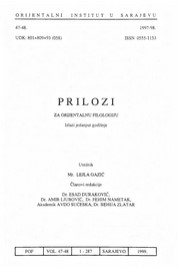VAKUFI U POŽEŠKOM I PAKRAČKOM SANDŽAKU U PERIODU OSMANSKE VLASTI
THE VAQFS IN POŽEGA AND PAKRAC SANJAKS AT THE TIME OF OTTOMAN POLITICAL ADMINISTRATION
Author(s): Fazileta HafizovićSubject(s): Public Administration, Political history, Government/Political systems, 16th Century, 17th Century, The Ottoman Empire
Published by: Orijentalni Institut u Sarajevu
Keywords: Vaqfs in Požega; Pakrac sanjaks; Ottoman Empire; Political history; Political administration;
Summary/Abstract: In Slavonia, a province of actual Republic of Croatia, Ottomans authority has been established at the first half of XVIth century, and has been definitely finished by concluding peace-agreement in Karlovci in 1699, even if it's really happened some earlier. Two sanjaks were established in this area: sanjak of Požega with the residence in Požega, which was catching the East and at the same time the biggest part of Slavonia; this sanjak has been based in 1538. The second sanjak was sanjak of Pakrac (Cazma's or Cernic's sanjak), in west part of Slavonia, whose name has been changed by the replacing the place of sanjak's residence. The sanjak of Pakrac was established in 1552. The both ones were periodically as a part of Bosnian Eyalet. On account of that these two sanjaks was considered as a border-area (serhat), that is sanjak of Požega was just the border-area big a smaller part, and sanjak of Pakrac was it completely, such status of them has been exercised strong influence on each sphere of everyday life, but also on activity in the sphere of everyday life, but also on activity in the sphere of Vakufs. Although, for that reason, these sanjaks were not suitable ground for establishing greater and considerable vakufs, many individuals, however, have built various buildings of religions and utilitar nature in various places of these sanjaks The people of vakufs themselves were also of various sotial status and standards: from administrators of sanjaks to small handicraftsmen. All traces of material culture have disappeared very soon after leaving of Ottoman peoples. There is today in Slavonia only one guarded facility from that period: the mosque in Đakovo, which was preserved by transformation into a church. That mosque today is as museum exponat with preserved elements of mosque and church.
Journal: Prilozi za orijentalnu filologiju
- Issue Year: 2000
- Issue No: 49
- Page Range: 231-251
- Page Count: 21
- Language: Bosnian

